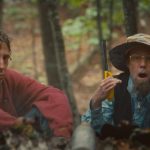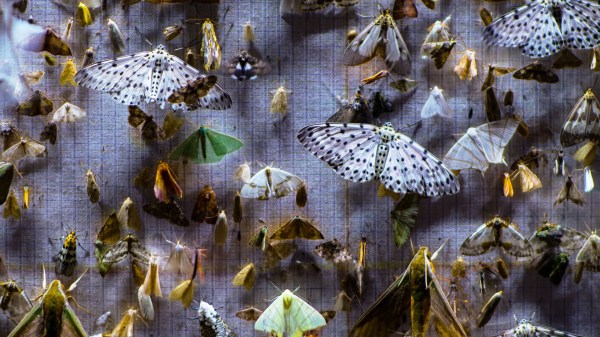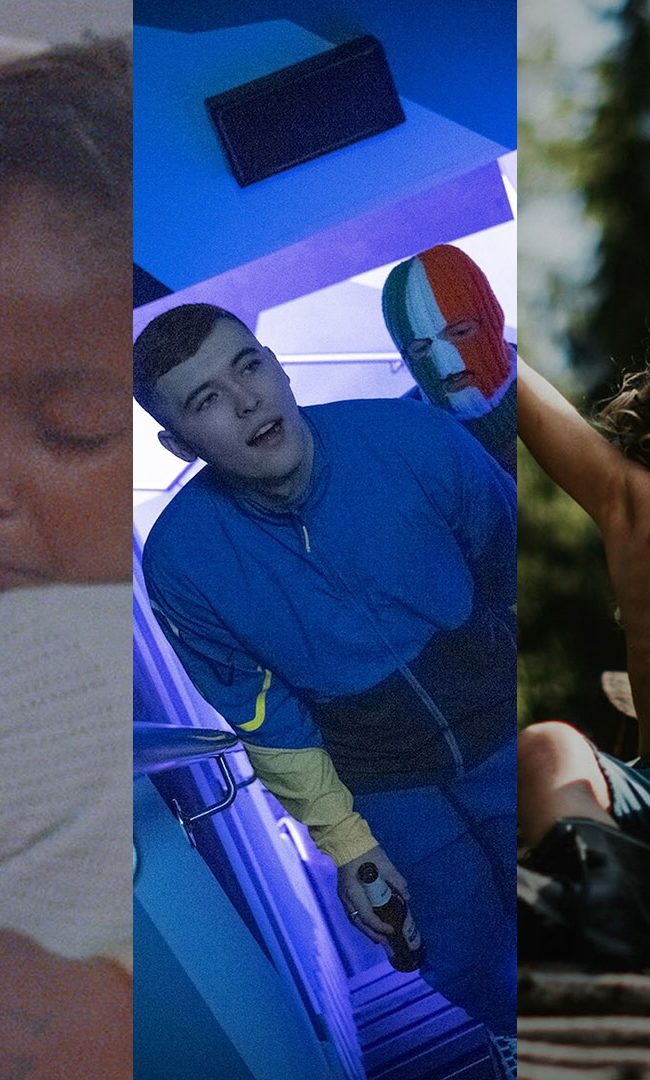A Conversation with Anirban Dutta & Anupama Srinivasan (NOCTURNES)
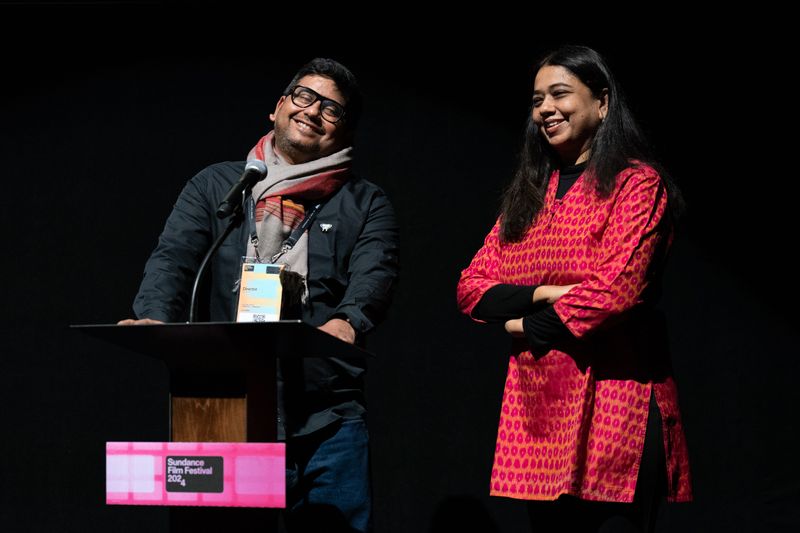
The atmosphere’s concentration of Carbon Dioxide is at an all-time high; extreme weather events have become more and more frequent; sea levels are rising faster than every before. It may feel like the world is ending, and maybe it is. But within the whirlwind of doom and gloom that leaves us wondering if there’s anything left to even save anymore, directors Anirban Dutta and Anupama Srinivasan provide an answer in their breathtaking documentary, Nocturnes.
Conversations about the climate crisis often operate on a grand (and human-centered) scale. Dutta and Srinivasan, however, use a microscopic vision to look at the hidden beauty providing hope yet concern for the environment. In a landscape as impressive as the Himalayan Mountain Range, Dutta and Srinivasan focus their camera on the ecosystem’s tessellation of moths.
While their newfound adoration is compellingly apparent in the film, a conversation with Dutta and Srinivasan made even clearer their passion for these beings. Here is that conversation, edited for length and clarity.
Hammer to Nail: How did you meet Mansi Mungee, the scientist who introduced viewers to the unexpectedly vibrant world of moths and how much did you know about moths before going into this project?
Anupama Srinivasan: Anirban and I were in the Western Himalayas doing some commission work on snow leopards and Mansi happened to be working there on the same project. She said she was just doing it to earn some money, but her real passion was moths. And we’re like, ‘Okay, that sounds weird.’ We didn’t know much about moths at all; like most people, we thought they were fairly ugly cousins of the butterfly. But the way she was describing it and her passion intrigued us. The visual imagery that her words created hit a note in our brains that this could become a way for us to express the feeling that we had become so disconnected with nature in our own lives back in Delhi, this very overcrowded, polluted, noisy place.
HtN: Can you recreate your initial reactions of seeing this surprisingly gorgeous congregation of moths?
Anirban Dutta: It was something very moving. The white canvas, the blue lights coming on it, and these moths in hundreds and thousands flocking to the screen, it brought back the memory of traveling cinema. As small children, when the screens used to be put up in our localities to show films, we used to run towards the screen.
A.S: I was blown over by the intricacy of the designs on every moth. Even after the scientists had finished their work, we [the filming crew] spent like three, four more hours filming every moth. It was like everything was a discovery. That childlike wonder and curiosity informed the way we constructed the film. Now, in our busy lives, we don’t seem to have the time to observe and enjoy, so how do we give that opportunity to the audience to observe things more minutely and have that childlike wonder?
HtN: The stillness of the film absolutely captures this wonder in that it gives viewers time not just to become familiar with the landscapes you’re putting so beautifully on screen, but become enveloped by them. This stillness creates a meditative patience that is present in the film, except for in one scene, when the camera is in motion and quite shaky. Why did you decide to break this stillness at this moment?
A.S: In terms of positioning ourselves as human beings within this world, the extreme long shots were definitely something we did very consciously to show this theme of scale. There’s this huge natural landscape and even a vehicle we may think of as very big is actually a tiny dot in the corner.
Midway in the film, Mansi has just given the instructions to her unit members and they’re setting out on this expedition. So we get in the car and now we’re on the expedition we’re like, “Okay, we are going to see something.” We wanted to show [through an active, hurried camera] that the human beings feel like they are in control, but immediately nature intervenes and they hit an obstacle.
HtN: The film has a heavy focus on the environment’s sound, in a way that is both sweeping – encapsulating the rustling of the trees, the singing of the birds, the hum of the moths – as well as intricate, in being able to hear each drop of rain, almost each flap of a moth’s wing. How did you capture this balance of delicate and sublime and what were your intentions in both?
A.D: When we went to the forest, the first thing that hit us was the amazing sound tapestry: the various kinds of crickets, the bugs, the wind, the rustling of the leaves. As the night faded, the sound changed and then the light came on and another kind of dance of nature started: when the moths in hundreds came towards the screen and sat, they created their own tapestry of sound, of colors, of forms. It was a huge visual and aural spectacle. We really felt humbled by this diversity and this splendor of nature and how we as humans know so little about this world.
As a human being, when we go into nature or into a city, you’ll see that our ears have a capacity to sometimes filter out sound and sometimes hear everything – our device is the best device in the world. So this was also something we were doing when we went to film. We could hear the flutter of the wings of the moth, but at the same time, we could hear the whole symphony.
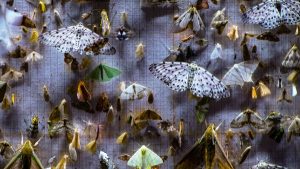
The space was created by 5.1 and 360 degree microphones and the specificity of the sound was recorded by the very unidirectional microphones. For example, to record the fluttering of the wings. When a small moth and a big moth flutter, they generate different frequencies, so you can actually take the sound and filter it out in the post production and create layers out of it.
HtN: What was your intention in decentering the climate crisis from the usual human narrative? How did you go about visually translating this?
A.S: There is a lot of conversation, at least superficially, about climate and global warming and how it’s affecting predominantly human communities. We also feel that there’s a level of numbness to this topic and we really wanted to find a fresh way of coming to it. Human beings are there, their work is important, and that’s very much a part of the drama in nature that is the forest – hey are impacted by it, they have to respond to it, but they are not the only things there. We didn’t want to privilege human beings. Through the lensing and shot-taking, many times we see the moths very big in the frame and the humans very small in the distance. Even the discussion of climate, we wanted to bring it towards the end of the film so that first we understand our place in the natural world, we fall in love with moths for their beauty and their color, and then we say “Oh my God, they’ve been here for hundreds of thousands of years, much longer than humans, and they have a very significant role to play.” So instead of making it preachy or didactic, we wanted to explore, be curious, discover with an open mind, and then learn something at the end.
HtN: What to you hope audiences feel when coming out of this film?
A.D: We feel that our world as getting completely consumed by devices. Something had been taken away, but was there a way to connect back to nature? It’s an invitation not only to us as filmmakers, but to others facing the same crisis to see Nocturnes and experience what we experience when we filmed in Arunachal Pradesh.
A.S: We wanted to create an experience where you come out of the film feeling calmer. For us, that’s the greatest gift we can give to anybody in these very fraught and difficult times. It’s not a superficial feel-good film, but we also don’t want to create a feeling that everything is gone and we need to get to the end fast. How can we be mindful about the ways we are interacting with the world, but at the same time, not feel so disheartened, like everything is over?
A.D: We want young and old – especially children – to come to the cinema and experience it because they should know that the world has immense beauty still to offer. You can cherish this beauty, you can nurture this beauty, you can hold onto this beauty. We want to give hope to the younger generation, not that the world is ending. We still feel that, with the climate crisis and everything that is happening, we have an opportunity to turn it around.
– Kaitlyn Hardy



